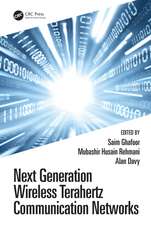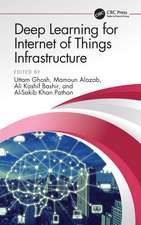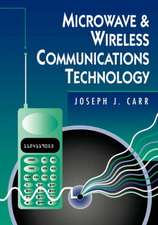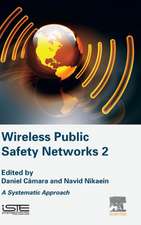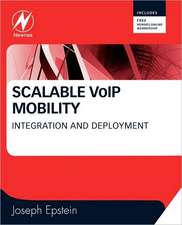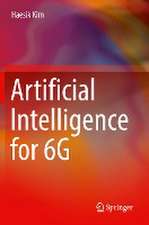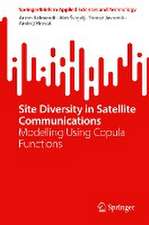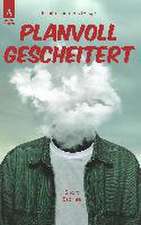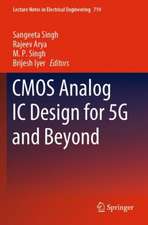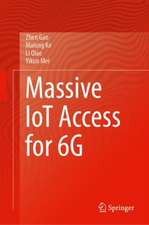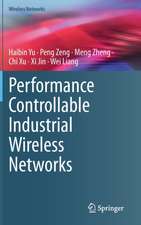Introduction to Digital Communications: Signals and Communication Technology
Autor Joachim Speidelen Limba Engleză Paperback – 3 apr 2022
The book is divided into three parts, the first of which addresses the principles of wire-line and wireless digital transmission over SISO links. Digital modulation, intersymbol interference, and various detection methods are discussed; models for realistic time-variant, wireless channels are introduced; and the equivalent time-variant baseband system model is derived. This book covers two new topics such as blockwise signal transmission and multicarrier modulation with orthogonal frequency-division multiplexing (OFDM) systems.
Since not all readers may be familiar with this topic, Part II is devoted to the theory of linear time-variant systems. The generalized convolution is derived, and readers are introduced to impulse response, the delay spread function, and system functions in the frequency domain. In addition, randomly changing systems are discussed. Several new examples and graphs have been added to this book.
In turn, Part III deals with MIMO systems. It describes MIMO channel models with and without spatial correlation, including the Kronecker model. Both linear and nonlinear MIMO receivers are investigated. The question of how many bits per channel use can be transmitted is answered, and maximizing channel capacity is addressed. Principles of space–time coding are outlined in order to improve transmission quality and increase data rates. In closing, the book describes multi-user MIMO schemes, which reduce interference when multiple users in the same area transmit their signals in the same time slots and frequency bands.
| Toate formatele și edițiile | Preț | Express |
|---|---|---|
| Paperback (2) | 532.56 lei 43-57 zile | |
| Springer International Publishing – 3 apr 2022 | 532.56 lei 43-57 zile | |
| Springer International Publishing – 10 dec 2019 | 586.70 lei 43-57 zile | |
| Hardback (1) | 708.28 lei 43-57 zile | |
| Springer International Publishing – 3 apr 2021 | 708.28 lei 43-57 zile |
Din seria Signals and Communication Technology
- 18%
 Preț: 952.89 lei
Preț: 952.89 lei - 18%
 Preț: 1559.80 lei
Preț: 1559.80 lei - 17%
 Preț: 361.80 lei
Preț: 361.80 lei - 18%
 Preț: 811.61 lei
Preț: 811.61 lei - 15%
 Preț: 585.26 lei
Preț: 585.26 lei - 18%
 Preț: 727.97 lei
Preț: 727.97 lei - 15%
 Preț: 585.90 lei
Preț: 585.90 lei -
 Preț: 393.35 lei
Preț: 393.35 lei - 20%
 Preț: 1002.73 lei
Preț: 1002.73 lei - 15%
 Preț: 641.71 lei
Preț: 641.71 lei - 20%
 Preț: 338.92 lei
Preț: 338.92 lei - 18%
 Preț: 1579.66 lei
Preț: 1579.66 lei - 18%
 Preț: 896.08 lei
Preț: 896.08 lei - 18%
 Preț: 847.11 lei
Preț: 847.11 lei - 18%
 Preț: 1234.77 lei
Preț: 1234.77 lei - 18%
 Preț: 905.54 lei
Preț: 905.54 lei - 15%
 Preț: 646.43 lei
Preț: 646.43 lei - 20%
 Preț: 662.48 lei
Preț: 662.48 lei - 15%
 Preț: 641.20 lei
Preț: 641.20 lei - 18%
 Preț: 1847.84 lei
Preț: 1847.84 lei - 18%
 Preț: 946.24 lei
Preț: 946.24 lei - 18%
 Preț: 1241.10 lei
Preț: 1241.10 lei - 20%
 Preț: 649.43 lei
Preț: 649.43 lei - 20%
 Preț: 993.28 lei
Preț: 993.28 lei - 18%
 Preț: 940.57 lei
Preț: 940.57 lei - 18%
 Preț: 1389.30 lei
Preț: 1389.30 lei - 20%
 Preț: 1003.50 lei
Preț: 1003.50 lei - 18%
 Preț: 953.52 lei
Preț: 953.52 lei - 20%
 Preț: 1001.16 lei
Preț: 1001.16 lei - 18%
 Preț: 1415.36 lei
Preț: 1415.36 lei - 15%
 Preț: 653.33 lei
Preț: 653.33 lei - 15%
 Preț: 645.60 lei
Preț: 645.60 lei - 15%
 Preț: 637.28 lei
Preț: 637.28 lei - 18%
 Preț: 948.79 lei
Preț: 948.79 lei - 18%
 Preț: 945.62 lei
Preț: 945.62 lei - 18%
 Preț: 836.36 lei
Preț: 836.36 lei - 18%
 Preț: 1225.46 lei
Preț: 1225.46 lei - 15%
 Preț: 635.01 lei
Preț: 635.01 lei - 15%
 Preț: 639.25 lei
Preț: 639.25 lei - 15%
 Preț: 646.30 lei
Preț: 646.30 lei - 15%
 Preț: 639.25 lei
Preț: 639.25 lei - 15%
 Preț: 712.36 lei
Preț: 712.36 lei - 20%
 Preț: 1006.12 lei
Preț: 1006.12 lei - 18%
 Preț: 970.56 lei
Preț: 970.56 lei
Preț: 532.56 lei
Preț vechi: 626.55 lei
-15% Nou
Puncte Express: 799
Preț estimativ în valută:
101.92€ • 106.01$ • 84.14£
101.92€ • 106.01$ • 84.14£
Carte tipărită la comandă
Livrare economică 14-28 aprilie
Preluare comenzi: 021 569.72.76
Specificații
ISBN-13: 9783030673598
ISBN-10: 3030673596
Pagini: 367
Ilustrații: XXIX, 367 p. 92 illus., 44 illus. in color.
Dimensiuni: 155 x 235 mm
Greutate: 0.56 kg
Ediția:2nd ed. 2021
Editura: Springer International Publishing
Colecția Springer
Seria Signals and Communication Technology
Locul publicării:Cham, Switzerland
ISBN-10: 3030673596
Pagini: 367
Ilustrații: XXIX, 367 p. 92 illus., 44 illus. in color.
Dimensiuni: 155 x 235 mm
Greutate: 0.56 kg
Ediția:2nd ed. 2021
Editura: Springer International Publishing
Colecția Springer
Seria Signals and Communication Technology
Locul publicării:Cham, Switzerland
Cuprins
Digital communications over single input single output channels.- Theory of linear time-variant systems.- Multiple Input Multiple Output wireless transmission.
Notă biografică
Joachim Speidel received his Dipl.-Ing. (M.Sc.) and Dr.-Ing. (Ph.D.) degree in Communications Engineering from the University of Stuttgart, Germany, in 1974 and 1980, respectively. From 1980-1992 he worked in various R&D positions for Philips in the broad field of digital video and data transmission. In 1992, he became a Professor at the Faculty of Computer Science, Electrical Engineering and Information Technology at the University of Stuttgart and Director of the Institute of Telecommunications. His research area includes telecommunications in wireless, fixed, electrical, and optical networks with a focus on coding, modulation, detection, and MIMO systems. Since 2017, he is a Professor Emeritus. Through his numerous publications and patents, Prof. Speidel has made extensive contributions to the field of telecommunications, its products, and international standards.
Textul de pe ultima copertă
This book offers students, scientists, and engineers an extensive introduction to the theoretical fundamentals of digital communications, covering single-input single-output (SISO), multiple-input multiple-output (MIMO), and time-variant systems. Further, the main content is supplemented by a wealth of representative examples and computer simulations.
The book is divided into three parts, the first of which addresses the principles of wire-line and wireless digital transmission over SISO links. Digital modulation, intersymbol interference, and various detection methods are discussed; models for realistic time-variant, wireless channels are introduced; and the equivalent time-variant baseband system model is derived. This book covers two new topics such as blockwise signal transmission and multicarrier modulation with orthogonal frequency-division multiplexing (OFDM) systems.
Since not all readers may be familiar with this topic, Part II is devoted to the theory of linear time-variant systems. The generalized convolution is derived, and readers are introduced to impulse response, the delay spread function, and system functions in the frequency domain. In addition, randomly changing systems are discussed. Several new examples and graphs have been added to this book.
In turn, Part III deals with MIMO systems. It describes MIMO channel models with and without spatial correlation, including the Kronecker model. Both linear and nonlinear MIMO receivers are investigated. The question of how many bits per channel use can be transmitted is answered, and maximizing channel capacity is addressed. Principles of space–time coding are outlined in order to improve transmission quality and increase data rates. In closing, the book describes multi-user MIMO schemes, which reduce interference when multiple users in the same area transmit their signals in the same time slots and frequency bands.
The book is divided into three parts, the first of which addresses the principles of wire-line and wireless digital transmission over SISO links. Digital modulation, intersymbol interference, and various detection methods are discussed; models for realistic time-variant, wireless channels are introduced; and the equivalent time-variant baseband system model is derived. This book covers two new topics such as blockwise signal transmission and multicarrier modulation with orthogonal frequency-division multiplexing (OFDM) systems.
Since not all readers may be familiar with this topic, Part II is devoted to the theory of linear time-variant systems. The generalized convolution is derived, and readers are introduced to impulse response, the delay spread function, and system functions in the frequency domain. In addition, randomly changing systems are discussed. Several new examples and graphs have been added to this book.
In turn, Part III deals with MIMO systems. It describes MIMO channel models with and without spatial correlation, including the Kronecker model. Both linear and nonlinear MIMO receivers are investigated. The question of how many bits per channel use can be transmitted is answered, and maximizing channel capacity is addressed. Principles of space–time coding are outlined in order to improve transmission quality and increase data rates. In closing, the book describes multi-user MIMO schemes, which reduce interference when multiple users in the same area transmit their signals in the same time slots and frequency bands.
Caracteristici
Is thoroughly revised and updated second edition Describes both single-input single-output (SISO) and wireless multiple-input multiple-output (MIMO) systems Offers comprehensive coverage of the theory of time-variant systems Includes all mathematical derivation




